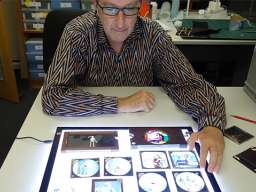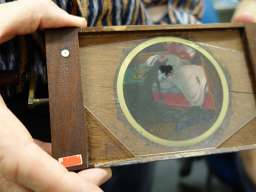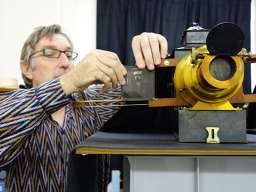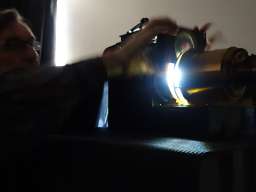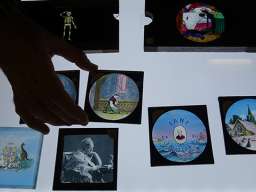Dr Jolly’s magic lanterns

In Dr Martyn Jolly’s office, there are items that are recognisable and reminiscent of most academics’ workspaces. There are desks and filing cabinets, boxes, books and papers.
And then there are the objects that are unrecognisable and unfamiliar.
They measure about a foot long. Made of glass, brass and mahogany they resemble an old-fashioned telescope. They’re mechanical-looking and vaguely nautical.
“I’ve got 16 magic lanterns, which is slightly embarrassing to say,” Dr Jolly, Head of the ANU School of Art and Design’s Photography and Media Arts workshop, says.
His colleague Associate Professor Martin Thomas jokes, “And he’s still pretending he’s not a collector.”
The lanterns are the subject of Dr Jolly’s Australian Research Council grant, Heritage in the limelight: the magic lantern in Australia and the world 1840-1940.
Together with Associate Professor Thomas and a team of scholars in history, anthropology, museum and heritage, the project will shine a light on the magic lantern and restore its place in our collective memory.
Invented in the 17th century, the magic lantern was a ubiquitous part of Australian culture from the mid-nineteenth to the mid-twentieth century. Magic lanterns projected hand-painted glass slides and hand-tinted photographic slides in theatres, halls, homes, schools and churches across Australia.
Dr Jolly outlines in his grant proposal:
As late as the 1940s, [they were used] by missionaries to raise funds and win converts; by universities and museums in scientific, anthropological and medical lectures; and by every cinema in the country to advertise local businesses.
The magic lantern was succeeded by the slide projector and eventually the data projector. Their vital role in our culture was essentially forgotten, with vast repositories of material left behind in our museums, libraries and archives.
“They've fallen through the cracks because the slides aren't original. They're copies,” Dr Jolly explains.
“There was an original negative, but from that negative probably thousands of copies were made to be sent all around the world. So they don't have much of a market value, not like an oil painting, which is clearly ‘authored’, obviously precious, and has been preserved and looked after.
“So we are only now finding out what historically informative material is out there.”
The project uses traditional research and practice-led research methods. In addition to his 16 magic lanterns, Dr Jolly has a sizeable collection of magic lantern slides, which he uses to explore how audiences experienced the magic lantern a hundred years ago.
“I’ll show you the most famous and the most popular magic lantern slide of the 19th century by a mile. And it’s still popular when I perform it even today,” he says.
On the glass is a coloured painting of a bearded man in bed. On the man’s floor is a pair of boots and a discarded jacket.
A second piece of glass overlaid onto it features two rats. This slide is turned, making one rat after the other jump into the man’s open mouth.
“This is called ‘Man Eating Rats’. The audience makes snoring noises and chomping noises,” Dr Jolly says.
The third piece of glass that animated the man’s bearded jaw was missing, so he created a new one, enlisting the help of another member of staff from the School of Art.
“Waratah Lahy painted this beautifully detailed beard for me,” Dr Jolly says, proudly.
He animated the slides so that the man’s bearded lower jaw moved up and down.
“This is why it’s so great researching at the ANU and at the School of Art – there’s just all this knowledge and talent,” he says.
“You want anything done, anything painted for you, just go and ask one of the best painters in Canberra.”
And for his performances of the magic lantern shows, such as the one he staged at a national art festival at the Bundanon Trust in September, he collaborates with staff and student musicians from the School of Music.
Dr Jolly’s fascination with the magic lantern has to do with the analogue characteristic of the technology.
“You can see how it works,” he says.
“When I pull up a file and do a bit of editing on Photoshop, I just click a button and the pixels change. I don't really know why or how the pixels change; I just know that they do.
“Whereas here I pull a lever and the lever pushes a piece of glass and that changes the image.
“There's something, I think, really satisfying about very mechanically knowable, polished wood, mahogany, teak, brass; making this virtual image that's projected into a dark space, which still produces a kind of magic and wonder recognisable to audiences today.”
Despite the magic lantern’s status as an antecedent technology, Dr Jolly doesn’t think the word ‘nostalgia’ applies to his interest.
“I don't want this to be just an antiquarian enthusiasm,” he states.
“From my point of view, there's unbroken lineage between this technology and the technology we experience now when we go to the cinema and watch TV, when we go onto our computer screens.”
Associate Professor Thomas supplied the example of one slide transitioning into another.
“This is one of the many ways magic lantern kind of prepared the eye, and prepared the public, for conventions in cinema. Where you have dissolves and the whole notion of the edit and that sort of thing.”
Dr Jolly’s team intends to recover “lost” slides, bringing those hiding in dusty archives back into the consciousness of the institutions that hold them. They also seek to provide staff with conceptual tools to make use of their collections.
“We're hopeful at the end of this project the whole culture of the lantern, which has virtually been forgotten, is much more present in the heritage industry,” Dr Jolly says.
“And for professionals who work in museums and archives, that they at least have some kind of handle on how they can use them themselves, display them, interpret them.”
Learn more about Dr Jolly's ARC research project at the project website.
